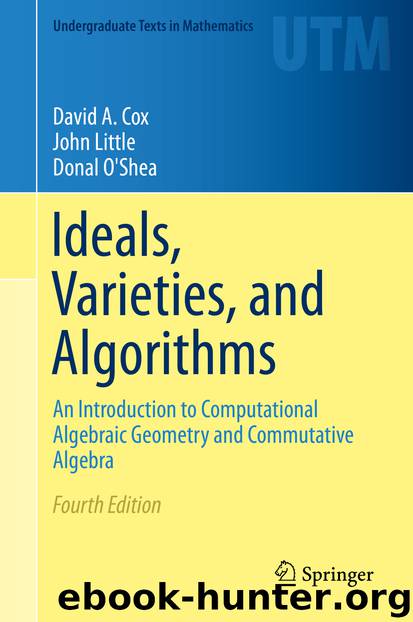Ideals, Varieties, and Algorithms by David A. Cox John Little & Donal O’Shea

Author:David A. Cox, John Little & Donal O’Shea
Language: eng
Format: epub
Publisher: Springer International Publishing, Cham
Thus, the conditions of Corollary 9 mean that g “follows generically over ” from the hypotheses .
This interpretation points out what is perhaps the main limitation of the Gröbner basis method in geometric theorem proving: it can only prove theorems where the conclusions follow generically over , even though we are only interested in what happens over . In particular, there are theorems which are true over but not over [see STURMFELS (1989) for an example]. Our methods will fail for such theorems.
When using Corollary 9, it is often unnecessary to consider the radical of . In many cases, the first power of the conclusion is in already. So most theorem proving programs in effect use an ideal membership algorithm first to test if , and only go on to the radical membership test if that initial step fails.
To illustrate this, we continue with the Circle Theorem of Apollonius from Example 3. Our hypotheses are the eight polynomials from (5)–(7). We begin by computing a Gröbner basis (using lex order) for the ideal , which yields
Download
This site does not store any files on its server. We only index and link to content provided by other sites. Please contact the content providers to delete copyright contents if any and email us, we'll remove relevant links or contents immediately.
Algorithms of the Intelligent Web by Haralambos Marmanis;Dmitry Babenko(8534)
Test-Driven Development with Java by Alan Mellor(7457)
Data Augmentation with Python by Duc Haba(7343)
Principles of Data Fabric by Sonia Mezzetta(7090)
Learn Blender Simulations the Right Way by Stephen Pearson(7036)
Microservices with Spring Boot 3 and Spring Cloud by Magnus Larsson(6850)
RPA Solution Architect's Handbook by Sachin Sahgal(6267)
Hadoop in Practice by Alex Holmes(6039)
The Infinite Retina by Robert Scoble Irena Cronin(5970)
Jquery UI in Action : Master the concepts Of Jquery UI: A Step By Step Approach by ANMOL GOYAL(5878)
Big Data Analysis with Python by Ivan Marin(5755)
Life 3.0: Being Human in the Age of Artificial Intelligence by Tegmark Max(5411)
Pretrain Vision and Large Language Models in Python by Emily Webber(4714)
Infrastructure as Code for Beginners by Russ McKendrick(4492)
WordPress Plugin Development Cookbook by Yannick Lefebvre(4217)
Functional Programming in JavaScript by Mantyla Dan(4129)
The Age of Surveillance Capitalism by Shoshana Zuboff(4129)
Embracing Microservices Design by Ovais Mehboob Ahmed Khan Nabil Siddiqui and Timothy Oleson(4015)
Applied Machine Learning for Healthcare and Life Sciences Using AWS by Ujjwal Ratan(3990)
